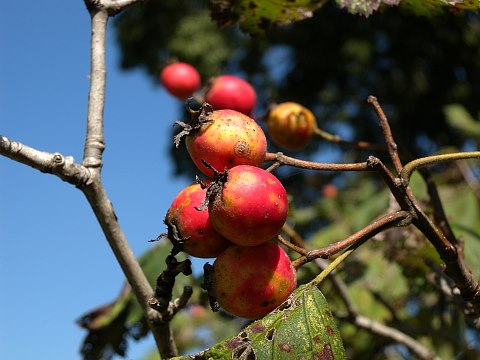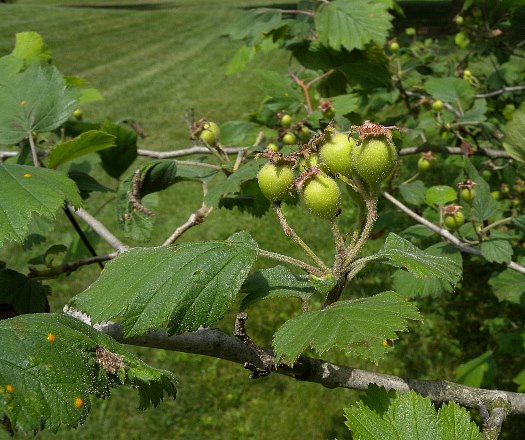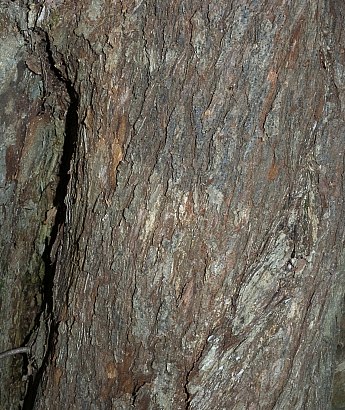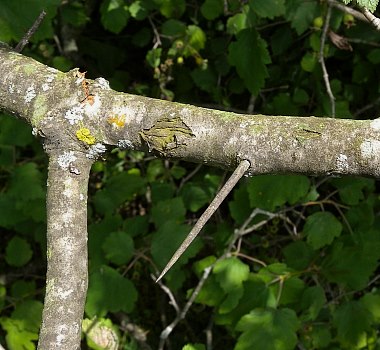
Small corymbs of white flowers are produced from short spur twigs; these corymbs span about 1½-3" across and they are rather flat-headed. The flowering stalks of the corymbs are light to reddish green and pubescent. Individual flowers are about 1" across, consisting of 5 white spreading petals, 5 green sepals that are united at the base, 20 stamens with pale yellow anthers, and an inferior ovary with 4-5 styles. Individual sepals are narrowly lanceolate in shape; they have conspicuous glandular teeth. The blooming period occurs for about 2 weeks during late spring; the flowers have an unpleasant odor. Fertile flowers are replaced by small globoid pomes (apple-like fruits) that become ¾-1" across at maturity during late summer. Young pomes are light green and pubescent, while mature pomes are yellowish red to scarlet and hairless (or nearly so). The interior of each mature pome contains firm flesh that is pale yellow and slightly juicy; it has an apple-like sweet-tart flavor. Each pome also contains 4-5 chunky seeds. The root system is woody and branching. Downy Hawthorn spreads by reseeding itself.

Cultivation: The preference is full or partial sun, moist to mesic conditions, and fertile loamy soil. However, other kinds of soil and drier conditions are also tolerated. The leaves of Downy Hawthorn are vulnerable to several foliar diseases, including cedar-hawthorn rust, scab, and leaf blight. As a result, the leaves are often battered from disease by the end of summer and usually succumb to premature leaf-drop.
Range & Habitat: The native Downy Hawthorn is common in the northern half of Illinois, while in the southern half of the state it is occasional or absent (see Distribution Map). Habitats include openings in bottomland woodlands, mesic savannas, woodland borders, thickets, banks of rivers, and abandoned pastures. Downy Hawthorn is a pioneer species that is intolerant of the dense shade that is cast by canopy trees. It is rarely cultivated as a landscape shrub or tree.

Faunal Associations: The nectar and pollen of the flowers attract honeybees, bumblebees, Halictid bees (including green metallic bees), Andrenine bees, wasps, Syrphid flies, dance flies (Empididae), Calliphorid flies, various beetles, and other insects (Robertson, 1929; Wilhelm & Rericha, 2017). Other insects feed destructively on various parts of Downy Hawthorn and other hawthorn trees (Crataegus). These insects include the wood-boring larvae of long-horned beetles (Cerambycidae), leaf beetles, various weevils, larvae of gall flies, plant bugs, aphids, leafhoppers, armored scale insects, treehoppers, leaf-eating larvae of sawflies, larvae of many moths, and larvae of two butterflies, the Viceroy (Limenitis archippus) and Red-spotted Purple (Limenitis arthemis astyanax). The Insect Table provides a more complete list of these insect feeders. Among vertebrate animals, such birds as the Wood Duck, Cedar Waxwing, Northern Cardinal, Fox Sparrow, Gray Catbird, Northern Mockingbird, Northern Flicker, Eastern Bluebird, American Robin, Wild Turkey, and Bobwhite Quail feed on the fruits of Downy Hawthorn and other hawthorn trees (see Bird Table for more information). Because many hawthorn trees are densely branched and thorny, they provide ideal protective cover and nesting sites for birds; this includes the Common Grackle, Willow Flycatcher, and Field Sparrow (Homan et al., 1996; DeGraaf, 2002; Best, 1978). Mammals that feed on the fruits include the Gray Fox, American Black Bear, Striped Skunk, and Woodland Vole; the American Moose and White-tailed Deer browse browse on the twigs, foliage, and fruits, while the Cottontail Rabbit gnaws on the bark of these small trees during winter (Martin et al., 1951/1961; Ludewig & Bowyer, 1985; Myers et al., 2004).

Photographic Location: The Arboretum at the University of Illinois in Urbana, Illinois.
Comments: Downy Hawthorn is one of the more common Crataegus spp. (hawthorns) in Illinois, particularly in the northern half of the state. It is relatively easy to recognize (for a hawthorn) because of its pubescent leaves, pubescent shoots, and pubescent immature fruits. The showy fruits of this species are among the first to mature among hawthorns, although they remain on the tree for only a short time before falling to the ground. The edible fruits have a pleasant flavor, although they are seedy. Across its range, there is some variability in the shape of the leaves and other characteristics of this small tree or shrub. As a result, many former species (Crataegus altrix, C. declivitatis, C. lanigera, C. nupera, C. pachyphylla, C. ridwayi, C. sera, C. umbrosa, C. valens, C. verna, and C. verosa) are now regarded as different forms of Crataegus mollis (Downy Hawthorn).